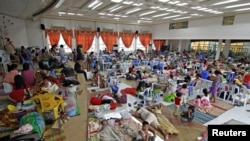A powerful typhoon plowed through the central Philippines on Sunday, bringing howling winds that toppled trees and power poles and cut off communications with areas where thousands were killed by a massive storm just over a year ago.
More than 1 million people had fled to shelters from coastal areas and landslide-prone villages by the time Typhoon Hagupit made landfall on Saturday night, bringing winds as high as 210 kilometers per hour (130 mph).
As the storm barrelled in from the Pacific, power was cut across most of the eastern island of Samar and nearby Leyte province, including Tacloban City, considered ground zero of the devastating super typhoon Haiyan last year.
"I can't penetrate the areas, I can't go north or south because of fallen trees and power lines. Many areas are flooded," Ben Evardone, congressman for Eastern Samar, said from his base in the provincial capital of Borongan.
Local radio reported at least two people had been killed in Eastern Samar, but that could not be confirmed by officials.
Hagupit had weakened to a Category 3 storm, two notches below "super typhoon," when it hit land, but still brought torrential rain and the risk of potentially disastrous storm surges of up to 4.5 meters (15 feet).
"This storm is still very strong. It could bring massive devastation,'' said weather forecaster Alvin Pura.
After churning across Samar island overnight, the storm was expected to make a second landfall on the island of Masbate around at midmorning Sunday local time, the Philippine weather bureau PAGASA said.
"There were areas that experienced storm surges,'' said Science and Technology Secretary Mario Montejo, adding that the agency was verifying the exact height of the waves.
Hagupit was moving west-northwest at 15 kph (9 mph), bringing winds of up to 160 kph (99 mph) near the center and gusts of up to 195 kph (121 mph).
Missing Manila?
The weather bureau said Hagupit — which means "lash" in Filipino — maintained its projected path toward Masbate, Romblon and Oriental Mindoro provinces, slightly north of areas devastated by Haiyan last year and missing the capital, Manila.
Residents of low-lying villages and landslide-prone areas had been evacuated to schools, civic centers, town halls, gyms and churches, the national disaster agency said.
There were more than 1.2 million people crowding over 1,500 evacuation centers across central Philippines, said Gwendolyn Pang, secretary-general of the Philippine Red Cross, adding local governments were providing the evacuees' basic needs.
Alexander Pama, head of the Office of Civil Defense, said disaster management planners were heeding President Benigno Aquino’s orders.
“We continue to follow the instructions of the president, given that we check and recheck and review … that the things that need to be done have been done,” Pama said.
At a recent meeting with the country’s disaster council, the president emphasized the urgent need to close gaps, such as making sure vulnerable residents were not only evacuated but moved to structures that could withstand powerful storms.
What was particularly worrisome to some first responders, like Philippines Red Cross Chairman Richard Gordon, was Hagupit’s projected expansive coverage.
A 'full-service' disaster
“It’s gonna be rain and floods and landslides and all that,” said Gordon. "This is a whole, full-service menu that is being served up by nature. [It] can even remobilize the lahars of Mayon volcano and even as far as Kanlaon.”
The Mayon and Kanlaon volcanoes are within the areas that will feel the impact of Hagupit. Mayon has been showing signs of activity since the end of summer.
The urgency to get the storm response right was high on government officials’ minds since the central Philippines has only begun to recover from Haiyan. That storm left more than 7,300 people dead or missing and brought some of the strongest winds ever recorded on land. Thousands of its victims are still living in tents.
Forecasters said Hagupit would linger in the country through Wednesday.
VOA's Simone Orendain contributed to this report.










